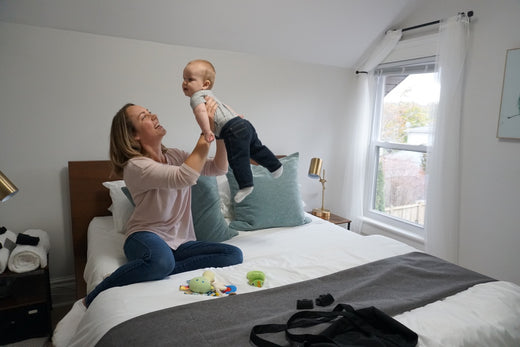Chest-sleeping with a newborn can be a beautiful way to bond and provide comfort for both the baby and parent. However, this practice also raises safety concerns that parents should be aware of. As a parent, you may have questions about the safety and implications of chest-sleeping with your newborn. In this blog post, we aim to provide guidance on chest-sleeping with your newborn, covering the benefits, risks, and best practices to ensure a positive experience for both you and your baby.
We understand that chest-sleeping can be a complex topic, with varying opinions and recommendations from healthcare providers. This post aims to provide an objective view on the subject, while also offering helpful tips and considerations for parents who may be considering chest-sleeping with their newborn. Whether you're a first-time parent or a seasoned pro, this post will provide valuable insights to help you navigate this important aspect of newborn care.
How Long Can a Newborn Sleep on Your Chest?
Chest-sleeping with a newborn presents safety concerns such as Sudden Infant Death Syndrome (SIDS) and suffocation risks. When a newborn sleeps on a parent's chest, their airway may become compromised, leading to potential breathing difficulties. While there are no specific guidelines regarding the duration of chest-sleeping, it is generally recommended to limit these sessions and be vigilant about your baby's safety.
To ensure the safety of your newborn, it's important to remain alert and attentive while chest-sleeping with them. Avoid chest-sleeping when you are overly tired or taking medications that may cause drowsiness. Additionally, it's important to avoid chest-sleeping with a baby on a couch or other soft surfaces, as this can increase the risk of suffocation.
While chest-sleeping with a newborn can be a beautiful way to bond, it's important to prioritize safety above all else. As a general guideline, it's recommended to limit chest-sleeping sessions and transition your baby to a safe sleep surface, such as a bassinet or crib, when you are ready to sleep.
What is The Best Chest-Sleeping Position?
The safest and most comfortable chest-sleeping positions involve placing your baby on their back, facing you, with their head turned to one side. This position helps maintain an open airway and reduces the risk of suffocation. It's important to avoid placing your baby on their stomach or side, as these positions can increase the risk of SIDS.
Proper head and neck support are crucial during chest-sleeping. Use your arm to support your baby's head and neck, ensuring that their face is not pressed against your body or covered by blankets or pillows. This will help keep their airway open and reduce the risk of suffocation.
Skin-to-skin contact can enhance the chest-sleeping experience by promoting bonding and providing a sense of security for your baby. This contact can also help regulate your baby's body temperature, heart rate, and breathing. To promote skin-to-skin contact, remove your shirt and place your baby directly on your bare chest. You can cover both you and your baby with a blanket to keep warm.
Is it a Bad Habit to Let Your Baby Sleep on You?
Chest-sleeping can offer several benefits for newborns, including bonding, emotional security, and physiological regulation. These benefits can contribute to a baby's overall well-being and development. Chest-sleeping can also promote skin-to-skin contact, which can help regulate a baby's body temperature, heart rate, and breathing.
However, there are risks associated with chest-sleeping, such as developing overdependence or sleep associations. If your baby becomes reliant on chest-sleeping to fall asleep, it may become challenging to transition them to independent sleeping. Additionally, there are potential safety concerns such as SIDS and suffocation risks.
To find a balance between chest-sleeping and promoting healthy, independent sleep habits, it's important to limit chest-sleeping sessions and gradually introduce other comforting sleep routines. This can help create a smooth transition to independent sleeping and reduce the risk of over dependence on chest-sleeping.
Consult Your Pediatricians
In summary, chest-sleeping with your newborn can provide benefits such as bonding and emotional security, but should be approached with caution due to safety concerns. To ensure a positive experience, it's important to follow safe sleep guidelines, such as placing your baby on their back with their head turned to one side and providing proper head and neck support. Additionally, it's important to remain attentive and avoid chest-sleeping when you are overly tired or taking medications that may cause drowsiness. Talk to your doctors to figure out what's best for you and your baby.
While chest-sleeping can be a beautiful way to bond with your newborn, it's also important to find a balance between chest-sleeping and promoting healthy, independent sleep habits. By gradually introducing other comforting sleep routines and limiting chest-sleeping sessions, parents can help their baby develop healthy sleep habits while still enjoying the benefits of chest-sleeping.
As a new mom, it's essential to be patient and consistent in your efforts to help your baby establish healthy sleep habits. To support your baby's sleep, consider investing in the most recommended blackout curtain by sleep specialists in North America. Use the code WELCOME10 for $10 off and start your journey towards peaceful nights and well-rested days.







